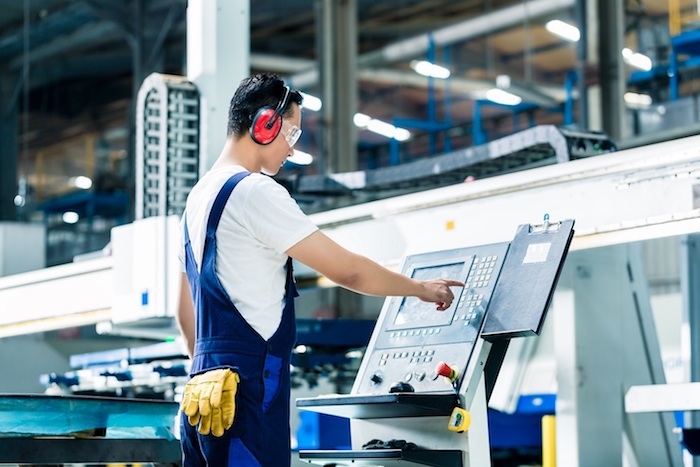
How to choose the right HMI for your manufacturing facility
March 4, 2019
By Mark Howard
 Photo: EU Automation
Photo: EU Automation March 4, 2019 – In his essay, “Natural-Born Cyborgs: Minds, Technologies, and the Future of Human Intelligence,” Andy Clark states that one day “we will stand revealed: cyborgs without surgery, symbionts without sutures.”
The essay argues that modern technology is already enough for us to be defined as cyborgs. However, we still require tools to communicate between our robotic counterparts in the factory. Here’s why choosing the right Human Machine Interface (HMI) is critical for communication with automation.
Let’s go back to basics. The role of an HMI is to effectively communicate information between a machine and an operator. In a typical manufacturing environment, this includes production data, as well as the communication of any errors and alerts on the production line. However, the wealth of data available has increased with the spread of Internet of Things (IoT)–enabled machinery.
With an increased number of sensors on the factory floor, facility managers and operation engineers now have access to intricate information that was previously unavailable or too time-consuming to extract.
HMIs lie at the very end of the IoT information stream. First, smart sensors gather the information feeding it to the Supervisory Control and Data Acquisition (SCADA) system that analyzes the data. Depending on the complexity of SCADA software, this data can be visualized in a format that is easy to understand, allowing the operator to interpret the information.
For example, the HMI can display the comparison between historic, average and current energy consumption rates on the factory floor, as a whole or as an itemized list, allowing the operator to keep a close eye on the situation and determine if any part is acting irregularly. If a part is using an unusual amount of energy, then the operator can isolate and identify the issue immediately either through the HMI or via physical inspection.
HMIs and the IoT
Before the advent of IoT, each machine on a production line had its own isolated HMI that could not interact with other systems. Generally speaking, these devices simply demonstrated whether a machine was functioning and allowed a user to control its operation. In the IoT landscape of cross-communicating systems and sharing information, advanced HMIs are fundamental to deal with the scale of data generated.
Advances in technology are allowing HMIs to take on many forms previously unthought of, with many modern systems being able to send analysis directly to smart devices such as smartphones and smartwatches. HMIs are no longer limited to screens on the shop floor. This is pushing HMI design to the forefront of priorities, as with limited screen space, the wealth of information generated must be condensed concisely.
A good HMI will present process information in a logical manner, with an option to allow the user to customize the data that is displayed.
As such, making the right choice when selecting an HMI for a production line is important. Put simply, every manufacturer’s HMI requirements will be different. A good way of choosing the right HMI for the application is to have a supplier that understands and stocks a large variety of different systems. As the industry continues to automate, the importance of selecting the correct HMI will increase, due to an increase in information that will enter and be processed by the system.
What are the benefits?
One of the main benefits of an effective HMI system is the ability to free up specialized staff from repetitive tasks, allowing them to take the reins on more technical jobs. Let’s say a production operator is tasked with performing maintenance checks on all equipment once per week. While monitoring the health of machinery is important, an intelligent HMI could automatically collect temperature, vibration and performance data from this equipment and highlight whether any anomalies are discovered.
By removing this menial task from the operator, this will increase the quality and attention they can give to critical jobs, such as unpredictable machine failures or large-scale production errors.
What’s more, a comprehensive HMI system will decrease the cost of other hardware over time. Due to the capabilities of the HMI, new hardware will not require as many add-on physical features, such as indicator lights, as all alerts will be transmitted via software and displayed on the HMI system. Automated insight into machine errors also means that fewer potentially hazardous manual inspections will be required to be carried out.
An HMI system will also decentralize decision making, allowing for more independence and remote business decisions to be achieved. For example, a business’s technical expert on CNCs could be away at a secondary production location. With an effective HMI, they can access the information generated by the CNC machine remotely, make decisions and input commands for the machine despite being away from the facility. A good HMI will not only improve data processing and understanding, but it will also help decrease costs and streamline procedures.
Clark’s aforementioned essay implies we’ve become so ingrained with technology that we could be described as cyborgs. In the factory, however, we’re still reliant on HMIs to accurately communicate data between man and machine. For manufacturers, choosing the right HMI is essential.
Mark Howard is manager at industrial parts supplier EU Automation, which stocks and sells new, used, refurbished and obsolete industrial automation spares.
Advertisement
- IBM announces new IoT-based asset performance management system
- Mexico won’t ratify new NAFTA with U.S. tariffs in place